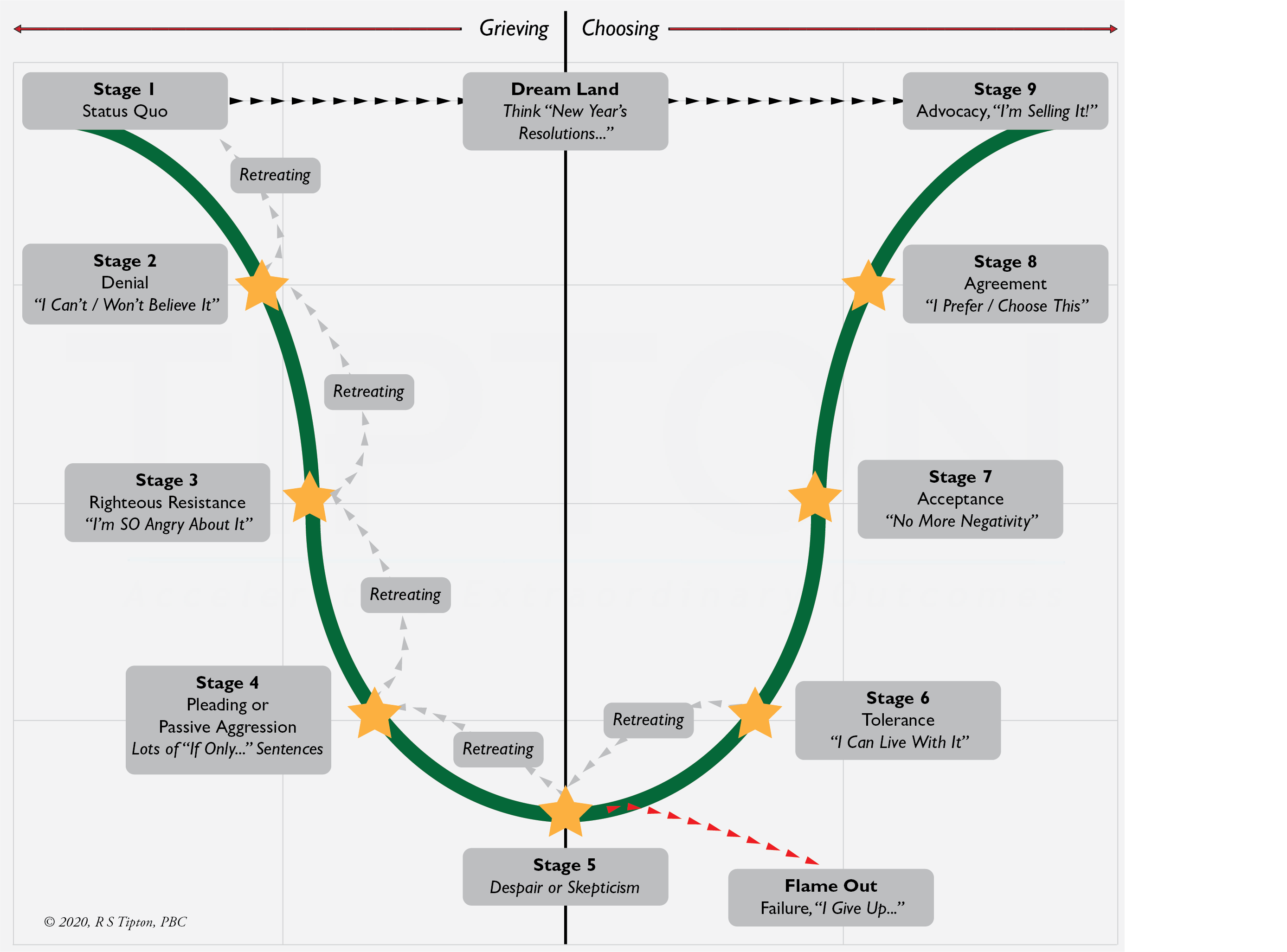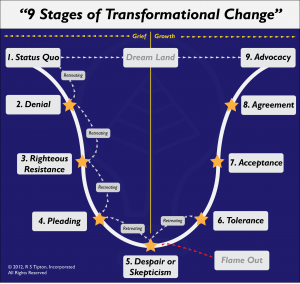
10 Jan 9 Stages of Transformational Change
Over the years, I’ve formulated my “9 Stages of Transformational Change” curve (see below) to try and bring some awareness as to why it feels hard. And, as I put together the graphic and started sharing it with others, it became obvious as to why transformational change feels “icky”:
Transformational change starts with grief.
Roll that around for a minute. It makes sense, right?
After all, change is a series of endings followed by beginnings — and when something ends (from a job to a relationship, from a favorite TV show to a certain style of shoes), we grieve. And then — when faced with the change, we then have the ability to “choose”, to “grow” as we move forward.
What do you think? Take a look at the graphic below — and then read my descriptions of each of the 9 stages. Do you see yourself in one of the stages? A family member? A coworker?
The “9 Stages of Transformational Change” curve shows a normal, predictable process. For many people I share this with, just the fact that the whole thing can be represented as a process is comforting! They can “plot” themselves somewhere, and then they can see that there’s an eventual “WAY OUT” as well.
Throughout the process, While we may only visit a stage for a blink of an eye related to some changes, we might get stuck for days, weeks, months or years in other stages depending upon the “bigness” of the transformational change we’re asked to make. My advice? Go through ALL the stages, but don’t get stuck “too long” in any of them.
Additionally, you can see the word “retreating” for many of the stages. All the way up until Stage 7 (acceptance), we can go backwards through the curve — revisiting stages we’ve already seen. This is also normal – and typical. However, once we reach Stage 7, we don’t slip backward — at least related to “this” transformational change!
Anyway, let’s take a look at the individual stages:
Dreamland (Stage 1 to Stage 9)
Okay — so this isn’t a “stage” by itself… Instead, it’s the “fast path” we’d prefer — to avoid the “ickiness” of transformational change. We want to jump directly from stage 1 (status quo) to stage 9 (advocacy), but it doesn’t work very well. Therefore, I call it “Dreamland.” An example of a “dreamland” jump? A New Year’s resolution. Do you ever wonder why “resolutions” don’t actually create real, sustainable change? Because there’s no grief and no growth involved… In short, we never commit, really, to the change.
Stage 1: Status Quo
Status Quo is simply what “is” at the beginning of the transformational change process. It is the known, the predictable, the safe, etc. And then — boom! Someone or something proposes a change, and we start “down” the transformational change curve. Next stop? Denial (and no, that’s not a river in Egypt!).
Stage 2: Denial
Denial is our first response to a change (and yes, this is exactly like Elizabeth Kubler-Ross’ grief and death cycle). This is when we find ourselves saying things like, “I can’t believe it.” For some, denial can be quick — while for others they can stay in denial for a LONG time — like forever. Consider the fact that according to the Center for Disease Control, 95% of the diabetes (which is type 2) in the US is caused one or two factors — overweight, or inactivity (or both together). Hmmm… Doesn’t that imply that 95% of all diabetes in the US could be totally preventable (if we’d get in better physical condition)? However, it seems many people are in denial about the need for better diet and exercise routines until AFTER they are diagnosed with diabetes. Now, that’s denial.
Stage 3: Righteous Resistance
The next stop along the transformational change curve is “righteous resistance” — or anger, or pissed-off-ness. It amazes me to see managers that “hate” the fact that people can become angry over proposed changes — after all (to these managers), people should just “buy-in” and go along, right? It’s easy to put together a proposed idea when you’re in a conference room — but it’s altogether different when REAL people get REAL angry about things. A transformational change leader recognizes that anger is expected and rather than trying to “quash” the anger, they help people move through their anger. Unfortunately, some people get stuck being angry for YEARS.
Stage 4: Pleading
After anger comes “pleading” or “bargaining” or “wishful thinking…” Listen for sentences starting with the words, “If Only…” and you’ll know you’re in the presence of pleading. “If only those idiots in the executive suite would pull their heads out…” “If only the government would make it illegal to outsource jobs to another country…” “If only my house was worth what it was in 2006…” And so on. Each time you say, “If only” you are living in the past and are denying the present. Bargaining is normal — but it’s also temporary.
Stage 5: Despair / Skepticism
Okay… So as a transformational change facilitator, my job is to push people into the “pit of despair” as quickly as possible — not because I’m sadistic, but because this is THE POINT where we have a choice as to what we want next. At Stage 5, we can choose four things:
- We can stay here, become an energy vampire (sucking it out of everyone around us), and live in despair or skepticism.
- We can go backwards to “pleading” because maybe we feel better being there.
- We can “Flame Out” — and give up on the change. Maybe it’s time to get out of the world of high finance, high stress and become a tour guide at Yellowstone. That’s okay too!
- We can choose to move forward — to GROW, to CHOOSE the change that we’re part of.
Stage 6: Tolerance
Okay — so if you find yourself here, it means you’ve made it “through the knothole” and you’ve decided to move forward THROUGH the change. And — at Stage 6 it’s clear you haven’t yet come to complete agreement with the change — but you say yes when someone like me asks you this question, “Can you live with it?” That’s tolerance to me — it’s possible to still harbor some negativity and move forward at the same time. Don’t wait until you feel 100% comfortable — have the courage to “live with it” even if you still have some negativity, and you can start the process of moving ahead.
Stage 7: Acceptance
There’s something different about the chart at Stage 7 — there’s no more “retreating” at this point. Why? Because at “acceptance” we are at least neutral about the change — our negativity has been resolved. We have made the choice to “take down” the rearview mirror completely and to move forward harboring no negative thoughts. This is a HUGE step in the transformational change process — and the sooner an entire group or organization reaches this stage, the better.
Stage 8: Agreement
Stage 8 represents “agreement” — where we’re beyond neutrality — we’re actively positive. It’s OUR CHOICE to feel and believe this way, and our behavior reflects it. We are openly optimistic, we share our hope for a positive outcome, and we anticipate the benefits coming from the change process. It’s rare to have entire organizations reach the “agreement stage” — it’s more typical to have excellence in transformation look more like 80% in stage 8, and 20% in “some other” stage (many in stage 7, some in stage 6, and some holdouts remaining in stages 5, 4, 3 and even 2.)
Stage 9: Advocacy
Getting to the advocacy stage is the holy grail of transformational change leadership. Why? Because at this stage people are so positive that they become advocates for the change itself. They have CHOSEN to become infectious, contagious, passionate sales people for the change — there’s no buy-in, no convincing, no arm twisting, no “or-else” statements. Advocates are high-energy, positive agents for change and it’s WONDERFUL to be in their presence.
The Leadership Lesson
So… There you have it. The “9 Stages of Transformational Change” — from the Status Quo to Advocacy in all of its glory. And — there’s a transformational change leadership lesson (or two) available here as well.
First — transformational change leaders (TCLs) recognize that their organizations “grieve then grow” behind them as changes are proposed and implemented. TCLs know this, plan for this, and manage the process associated with this.
Second — TCLs (using the advice from General George Patton) will occasionally “turn around” in their organizations and make sure there’s someone following them! In other words, a TCL won’t let the change get “too far ahead” of the organization. TCLs, by nature are forward-looking, strategic, positive people — but they also realize that change happens THROUGH people, not in spite of them.
One final question… I asked you at the beginning to see if you recognize yourself in any stage of the transformational change curve. Do you? Do you see yourself in “different places” for different reasons in different situations? That’s normal. We can be in all nine stages in different parts of our lives.
Hopefully, though, we are moving THROUGH the stages and not getting stuck in any one of them. That’s my hope for you!




No Comments